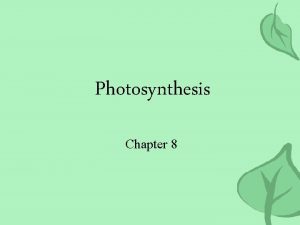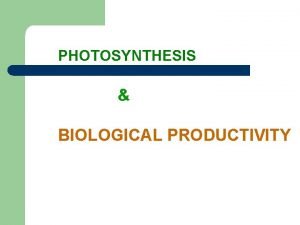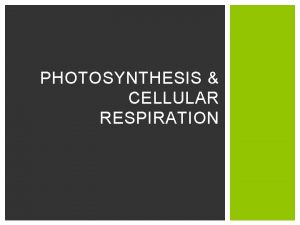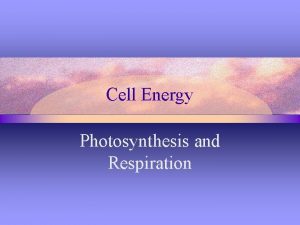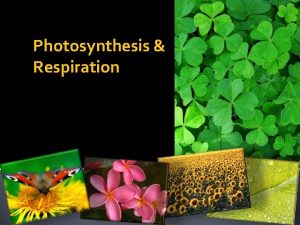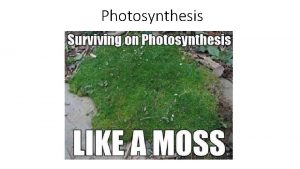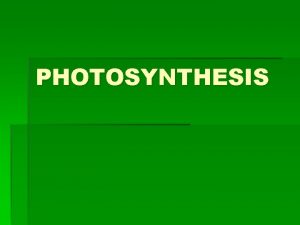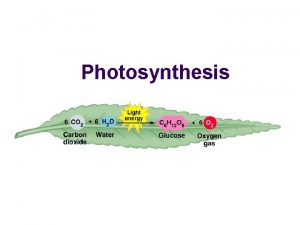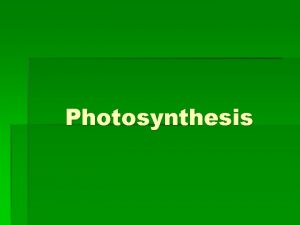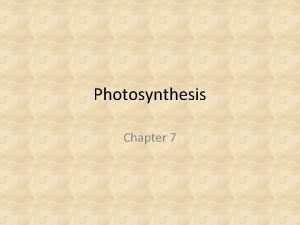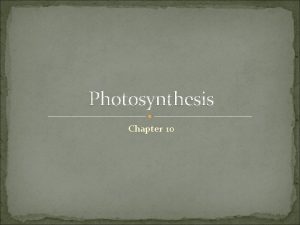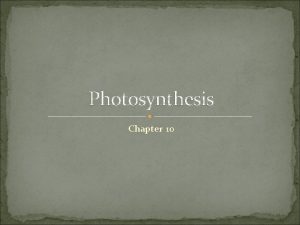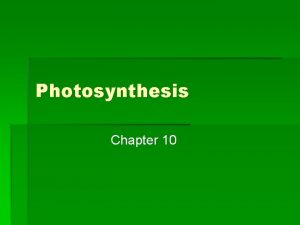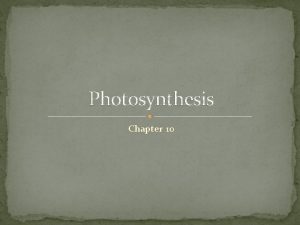Chapter 5 2 Photosynthesis Photosynthesis Photosynthesis The process
























- Slides: 24

Chapter 5. 2 Photosynthesis

Photosynthesis § Photosynthesis – The process that plants use to make energy from the sun. § The process by which plants and some other organisms convert light energy to useable chemical energy. § The Student of the Day will be able to answer this question. § § § What element is Organic Chem. centered around? What is a molecule made of 6 Carbons? A plant makes sugar molecules which store energy and allow the plant to grow and reproduce.

How does a plant get energy? § Plants need supplies in order to make sugar. § Where do you think the Carbon comes from? § Where do you think the Hydrogen comes from? § A plant will take in three things in order to make a sugar molecule; Carbon Dioxide, Water and Sunlight.

What else does a plant make? § Along with the 1 sugar molecule that a plant will make during photosynthesis a plant makes Oxygen molecules as a waste product. § What does a plant do with the Oxygen molecules that it makes? CO 2 + H 2 O + sunlight C 6 H 12 O 6 + O 2 +

Think about it! CO 2 + H 2 O + sunlight C 6 H 12 O 6 + O 2 • How many Carbons are in the sugar molecule? Hydrogen? Oxygen? • How many Carbons are in the reactant? Hydrogen? Oxygen? • This molecular equation is not balanced. • 6 CO 2 + 6 H 2 O + sunlight C 6 H 12 O 6 + 6 O 2 • The equation now has the same number of atoms in the product as it does in the reactant.

Where does this process take place? § What are the leaves of a plant made of? § The organelle inside a plant cell where photosynthesis takes place is the chloroplast. § Inside a chloroplast are tiny discs that look like a stack of nickels called thylakoids. § Inside thylakoid are pigments. § The pigment inside thylakoid will absorb light from the sun.

Chloroplast

Visible Light Spectrum § The sun produces many different sized waves. A small percentage of these waves we can see or hear. The rest of the waves our brains cannot comprehend.

More about light waves § Certain light waves that come down from the sun are absorbed while others are reflected. § For example your shirt is absorbing and/or reflecting all types of color. § If you are wearing a white shirt, it is reflecting all of the colors back to your eye. § Those that are wearing black shirt are absorbing all of the waves of color. § Story time: Very Stupid criminal!

Pigments § There are four types of pigment in the thylakoid that we will learn about. 1. Chlorophyll A – absorbs all spectrums of light except for green and blues 2. Chlorophyll B - absorbs all spectrums of light except for yellows, greens and some blues. 3. Carotenoids - absorbs all spectrums of light except for reds, oranges and yellows. 4. Xanthophyll - absorbs all spectrums of light except for yellow.

Absorption Spectra of photosynthesis pigments.

Sample Paper Chromatography

Stages of Photosynthesis § There are three important stages of photosynthesis. § Light Dependant Reaction – needs light in order to function. § There are two steps in the Light Dependant Rxn. - Light Absorption - Electron Transport § Light Independent – Does not mean that it has to be dark to work. It can work both at night & at daytime. - Calvin Cycle

3 Stages of Photosynthesis

Stage 1: Light Absorption § Step 1: Light hits the thylakoid in the plant cell and the pigment absorbs the energy. § Step 2: When the light hits the thylakoid it excites an electron in the pigment. The ejumps to a higher energy level and moves to a molecule near the thylakoid. § Step 3: An enzyme takes water into the cell and breaks it into 2 H atoms and an O atom. The H atoms are stripped of their electron which replace the electron that has just been bumped up. What do you think happens to the Oxygen?

Here’s how light absorption works.

Stage 2: Electron Transport § Electron Transport Chain – Series of molecules through which excited e-s are passed along the thylakoid membrane. § Step 1 – The excited e-s is passed through a series of molecules. § Step 2 – The energy lost by the electron causes more Hydrogen to move into the thylakoid. Where do the Hydrogen come from? This causes a concentration gradient. § If you need to move against a concentration gradient what do you need?

Stage 2: Electron Transport Cont. § One pump places a phosphate onto ADP making ATP. § Another pump takes the leftover Hydrogen and puts it onto a molecule called NADP which turns it into NADPH. § NADPH is an e- carrier that provides the high energy electron needed to make Carbon. Hydrogen bonds in the next Stage (The Calvin Cycle.


Photosystems § Photosystem II § Photosystem I see overhead

Light Independent Reaction § So far we have talked about water and light energy. What part of photosynthesis haven’t we talked about? § Carbon Dioxide Fixation – The transfer of CO 2 to organic compounds. The process of making C 6 H 12 O 6. § The most common Carbon Dioxide Fixation reaction that occurs in photosynthesis is the Calvin Cycle.

Calvin Cycle 1. 3 CO 2 molecules are added to 3 5 -Carbon compounds. 2. The 3 6 -Carbon compounds split into 6 3 Cabon compounds.

Calvin Cycle Continued § A phosphate from ATP & an e- from NADPH turn the 3 Carbon Compounds into 3 Carbon sugars. 3. One 3 Carbon sugar is used to make carbohydrates for energy storage. 4. The other 5 3 -Carbon sugars turn into 3 5 Carbon compounds used to continue the cycle. § Factors that would affect photosynthesis: Light, CO 2 and temp. (enzyme activity)

 Hát kết hợp bộ gõ cơ thể
Hát kết hợp bộ gõ cơ thể Slidetodoc
Slidetodoc Bổ thể
Bổ thể Tỉ lệ cơ thể trẻ em
Tỉ lệ cơ thể trẻ em Voi kéo gỗ như thế nào
Voi kéo gỗ như thế nào Thang điểm glasgow
Thang điểm glasgow Chúa yêu trần thế
Chúa yêu trần thế Môn thể thao bắt đầu bằng từ chạy
Môn thể thao bắt đầu bằng từ chạy Thế nào là hệ số cao nhất
Thế nào là hệ số cao nhất Các châu lục và đại dương trên thế giới
Các châu lục và đại dương trên thế giới Công thức tính độ biến thiên đông lượng
Công thức tính độ biến thiên đông lượng Trời xanh đây là của chúng ta thể thơ
Trời xanh đây là của chúng ta thể thơ Mật thư tọa độ 5x5
Mật thư tọa độ 5x5 101012 bằng
101012 bằng độ dài liên kết
độ dài liên kết Các châu lục và đại dương trên thế giới
Các châu lục và đại dương trên thế giới Thể thơ truyền thống
Thể thơ truyền thống Quá trình desamine hóa có thể tạo ra
Quá trình desamine hóa có thể tạo ra Một số thể thơ truyền thống
Một số thể thơ truyền thống Cái miệng nó xinh thế
Cái miệng nó xinh thế Vẽ hình chiếu vuông góc của vật thể sau
Vẽ hình chiếu vuông góc của vật thể sau Thế nào là sự mỏi cơ
Thế nào là sự mỏi cơ đặc điểm cơ thể của người tối cổ
đặc điểm cơ thể của người tối cổ Ví dụ giọng cùng tên
Ví dụ giọng cùng tên Vẽ hình chiếu đứng bằng cạnh của vật thể
Vẽ hình chiếu đứng bằng cạnh của vật thể
































